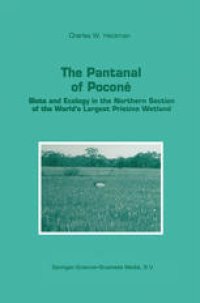
Ebook: The Pantanal of Pocone: Biota and Ecology in the Northern Section of the World’s Largest Pristine Wetland
Author: Charles W. Heckman (auth.)
- Tags: Ecology, Nature Conservation, Freshwater & Marine Ecology, Plant Sciences, Zoology
- Series: Monographiae Biologicae 77
- Year: 1998
- Publisher: Springer Netherlands
- Edition: 1
- Language: English
- pdf
There are many famous wetlands in the world that have been deemed important for the homeostasis ofthe biosphere and accorded some form ofprotected status in view of the richness of their flora and fauna. T}1e Pantanal, located almost directly in the center ofthe South American continent, is among the largest such wetlands in the world. It is, in fact, the largest wetland that is still in a nearly natural state and has not been extensively modified by man for agriculture. The extent of the region covered by flood waters at the end of each rainy season varies from year to year, sometimes considerably, so estimates of the exact area it occupies have varied enormously. The size of the 2 2 Pantanal has been reported to be between 80,000 km (Bonetto, 1975) and 250,000 km (Tundisi and Matsumura-Tundisi, 1985). The most co~on1y accepted estimates at the present time are approximately 130,000 to 140,000 km , supported by estimates made from Nimbus-7 satellite observations (Hamilton et al. , 1996). However, Por (1995) suggested that the area extending into Bolivia and Paraguay has not been satisfactorily 2 surveyed, leading him to accept the figure of 200,000 km as the area of the entire Pantanal, ineluding all of its extensions. The main reason for the year to year variation in the extent of the flooding is the considerable difference in timing of the rainfall on the watershed.
The Pantanal of Pocone provides an in-depth analysis of the ecological relationships in the northern part of the world's largest wetland in a near-natural state. It is the only book available that offers a survey of the flora and fauna of the region, making it particularly interesting for researchers in biodiversity and the biogeography of the Neotropical Region. It stands out among the few books on this vast area of seasonally flooded plains in surveying all major taxa of plants and animals, providing data obtained during a study lasting nearly four years and information available in myriad short publications in journals, many of which are very hard to obtain. The book will be of interest to researchers in the wet-and-dry climatic zone of the tropics worldwide and to ecologists in South America in particular. It is meant to be a basic sourcebook of tropical ecology and wetland biology.
The Pantanal of Pocone provides an in-depth analysis of the ecological relationships in the northern part of the world's largest wetland in a near-natural state. It is the only book available that offers a survey of the flora and fauna of the region, making it particularly interesting for researchers in biodiversity and the biogeography of the Neotropical Region. It stands out among the few books on this vast area of seasonally flooded plains in surveying all major taxa of plants and animals, providing data obtained during a study lasting nearly four years and information available in myriad short publications in journals, many of which are very hard to obtain. The book will be of interest to researchers in the wet-and-dry climatic zone of the tropics worldwide and to ecologists in South America in particular. It is meant to be a basic sourcebook of tropical ecology and wetland biology.
Content:
Front Matter....Pages i-xxx
Introduction....Pages 1-7
Geography....Pages 8-33
Geology....Pages 34-44
Climate....Pages 45-58
Hydrology....Pages 59-76
Water chemistry....Pages 77-128
Flora....Pages 129-203
Fauna....Pages 207-387
Biotic communities....Pages 388-417
Seasonal succession....Pages 418-435
Ecosystem dynamics....Pages 436-471
Human impact....Pages 472-481
Conservation....Pages 482-505
Summary and Conclusions....Pages 506-509
Acknowledgements....Pages 510-511
Literature....Pages 512-564
Back Matter....Pages 565-624
The Pantanal of Pocone provides an in-depth analysis of the ecological relationships in the northern part of the world's largest wetland in a near-natural state. It is the only book available that offers a survey of the flora and fauna of the region, making it particularly interesting for researchers in biodiversity and the biogeography of the Neotropical Region. It stands out among the few books on this vast area of seasonally flooded plains in surveying all major taxa of plants and animals, providing data obtained during a study lasting nearly four years and information available in myriad short publications in journals, many of which are very hard to obtain. The book will be of interest to researchers in the wet-and-dry climatic zone of the tropics worldwide and to ecologists in South America in particular. It is meant to be a basic sourcebook of tropical ecology and wetland biology.
Content:
Front Matter....Pages i-xxx
Introduction....Pages 1-7
Geography....Pages 8-33
Geology....Pages 34-44
Climate....Pages 45-58
Hydrology....Pages 59-76
Water chemistry....Pages 77-128
Flora....Pages 129-203
Fauna....Pages 207-387
Biotic communities....Pages 388-417
Seasonal succession....Pages 418-435
Ecosystem dynamics....Pages 436-471
Human impact....Pages 472-481
Conservation....Pages 482-505
Summary and Conclusions....Pages 506-509
Acknowledgements....Pages 510-511
Literature....Pages 512-564
Back Matter....Pages 565-624
....